2017 NISSAN LEAF warning light
[x] Cancel search: warning lightPage 121 of 424
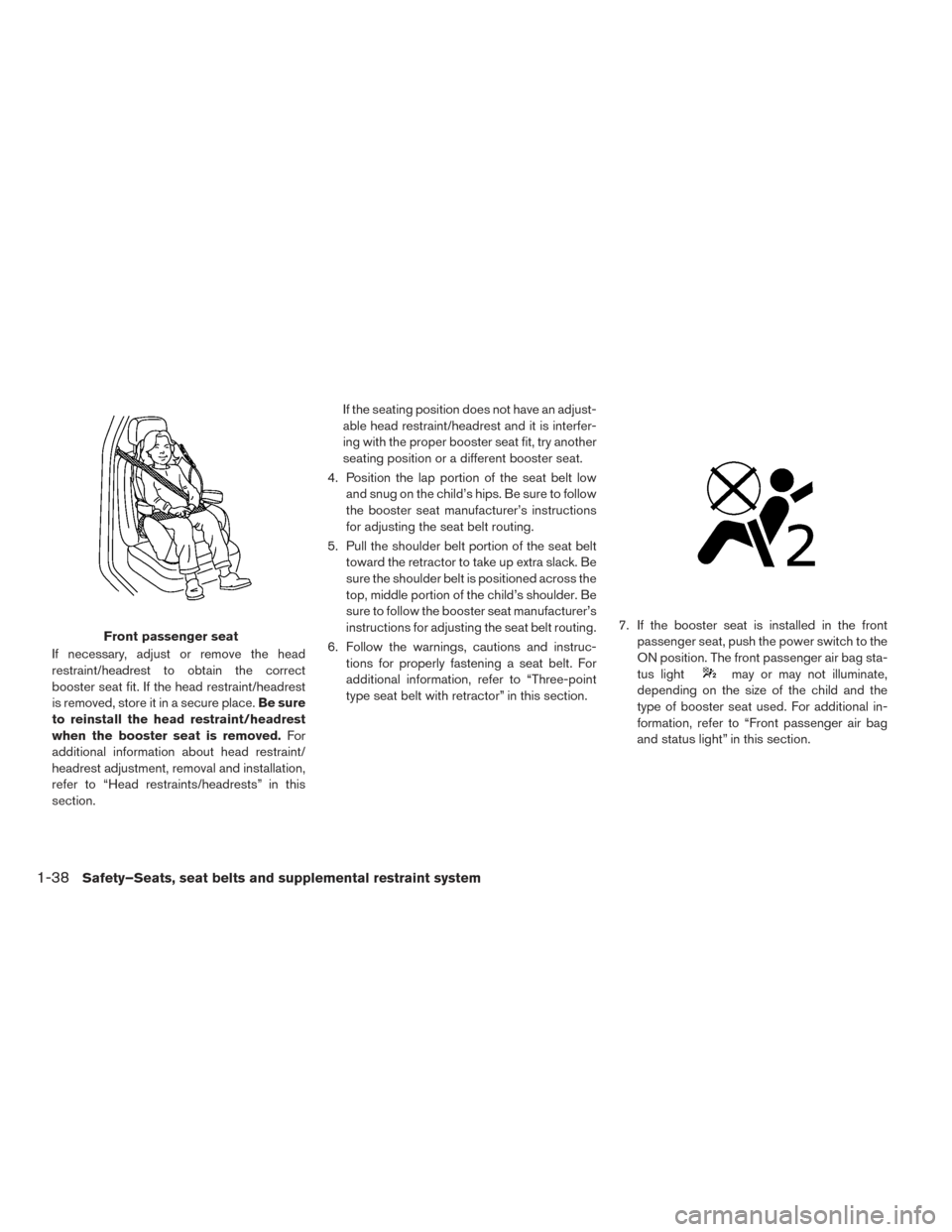
If necessary, adjust or remove the head
restraint/headrest to obtain the correct
booster seat fit. If the head restraint/headrest
is removed, store it in a secure place.Be sure
to reinstall the head restraint/headrest
when the booster seat is removed. For
additional information about head restraint/
headrest adjustment, removal and installation,
refer to “Head restraints/headrests” in this
section. If the seating position does not have an adjust-
able head restraint/headrest and it is interfer-
ing with the proper booster seat fit, try another
seating position or a different booster seat.
4. Position the lap portion of the seat belt low and snug on the child’s hips. Be sure to follow
the booster seat manufacturer’s instructions
for adjusting the seat belt routing.
5. Pull the shoulder belt portion of the seat belt toward the retractor to take up extra slack. Be
sure the shoulder belt is positioned across the
top, middle portion of the child’s shoulder. Be
sure to follow the booster seat manufacturer’s
instructions for adjusting the seat belt routing.
6. Follow the warnings, cautions and instruc- tions for properly fastening a seat belt. For
additional information, refer to “Three-point
type seat belt with retractor” in this section. 7. If the booster seat is installed in the front
passenger seat, push the power switch to the
ON position. The front passenger air bag sta-
tus light
may or may not illuminate,
depending on the size of the child and the
type of booster seat used. For additional in-
formation, refer to “Front passenger air bag
and status light” in this section.
Front passenger seat
1-38Safety–Seats, seat belts and supplemental restraint system
Page 122 of 424

PRECAUTIONS ON SRS
This SRS section contains important information
concerning the following systems.
• Driver and front passenger supplemental front-impact air bag (NISSAN Advanced Air Bag
System)
• Front seat-mounted side-impact supplemental air bag
• Roof-mounted curtain side-impact and rollover (if so equipped) supplemental air bag
• Seat belt with pretensioner(s) (front seats)
Supplemental front-impact air bag system
The NISSAN Advanced Air Bag System can help
cushion the impact force to the head and chest of
the driver and front passenger in certain frontal
collisions.
Front seat-mounted side-impact supple-
mental air bag system
This system can help cushion the impact force to
the chest and pelvic area of the driver and front
passenger in certain side impact collisions. The
side air bags are designed to inflate on the side
where the vehicle is impacted. Roof-mounted curtain side-impact and
rollover (if so equipped) supplemental air
bag system
This system can help cushion the impact force to
the head of occupants in front and rear outboard
seating positions in certain side impact collisions.
In a side impact, the curtain air bags are designed
to inflate on the side where the vehicle is im-
pacted. If so equipped, in a rollover, the curtain air
bags are designed to inflate and remain inflated
for a short time.
The SRS is designed to
supplementthe crash
protection provided by the driver and passenger
seat belts and is not a substitute for them. Seat
belts should always be correctly worn, and the
occupant should be seated a suitable distance
away from the steering wheel, instrument panel
and door finishers. For additional information,
instructions, and precautions on seat belt usage,
refer to “Seat belts” in this section. The supplemental air bags operate only
when the power switch is in the ON posi-
tion.
After the power switch is placed in the ON
position, the supplemental air bag warning
light illuminates. The supplemental air bag
warning light will turn off after about 7 sec-
onds if the system is operational.
SUPPLEMENTAL RESTRAINT
SYSTEM (SRS)
Safety–Seats, seat belts and supplemental restraint system1-39
Page 123 of 424
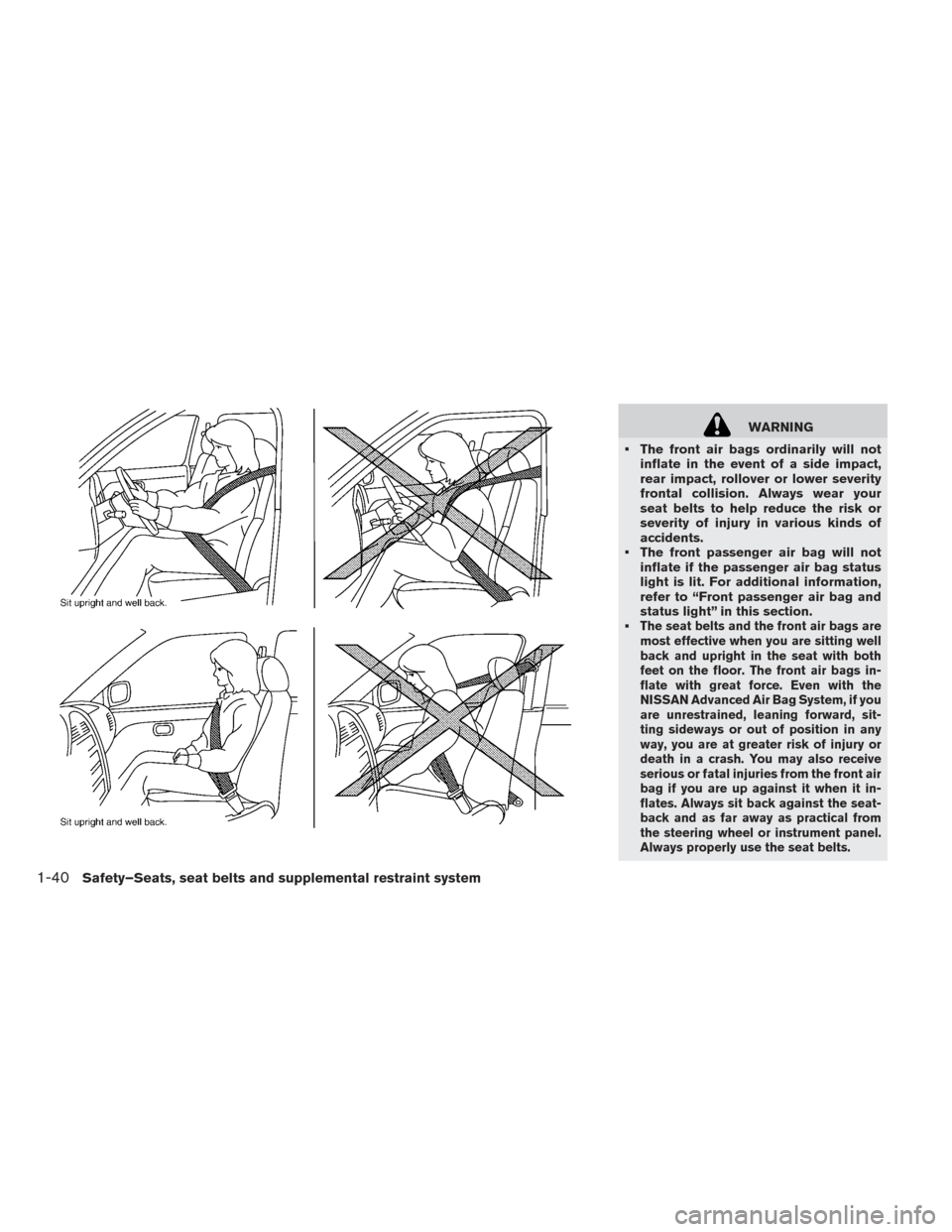
WARNING
• The front air bags ordinarily will not inflate in the event of a side impact,
rear impact, rollover or lower severity
frontal collision. Always wear your
seat belts to help reduce the risk or
severity of injury in various kinds of
accidents.
• The front passenger air bag will not inflate if the passenger air bag status
light is lit. For additional information,
refer to “Front passenger air bag and
status light” in this section.
•
The seat belts and the front air bags are
most effective when you are sitting well
back and upright in the seat with both
feet on the floor. The front air bags in-
flate with great force. Even with the
NISSAN Advanced Air Bag System, if you
are unrestrained, leaning forward, sit-
ting sideways or out of position in any
way, you are at greater risk of injury or
death in a crash. You may also receive
serious or fatal injuries from the front air
bag if you are up against it when it in-
flates. Always sit back against the seat-
back and as far away as practical from
the steering wheel or instrument panel.
Always properly use the seat belts.
1-40Safety–Seats, seat belts and supplemental restraint system
Page 128 of 424

• If a forward-facing child restraint isinstalled in the front passenger seat,
do not position the front passenger
seat so the child restraint contacts the
instrument panel. If the child restraint
does contact the instrument panel, the
system may determine the seat is oc-
cupied and the passenger air bag may
deploy in a collision. Also the front
passenger air bag status light may not
illuminate. For additional information
about installing and using child re-
straints, refer to “Child restraints” in
this section.
• Confirm the operating condition with the front passenger air bag status
light.
• If you notice that the front passenger air bag status light is not operating as
described in this section, get the occu-
pant classification system checked. It
is recommended that you visit a
NISSAN certified LEAF dealer for this
service.
• Until you have confirmed with a dealer that your passenger seat occupant
classification system is working prop-
erly, position the occupants in the rear
seating positions. • Do not position the front passenger
seat so it contacts the rear seat. If the
front seat does contact the rear seat,
the air bag system may determine a
sensor malfunction has occurred and
the front passenger air bag status light
may illuminate and the supplemental
air bag warning light may flash.
This vehicle is equipped with the NISSAN Ad-
vanced Air Bag System for the driver and front
passenger seats. This system is designed to
meet certification requirements under U.S. regu-
lations. It is also permitted in Canada. All of the
information, cautions and warnings in this
manual apply and must be followed.
The driver supplemental front-impact air bag is
located in the center of the steering wheel. The
front passenger supplemental front-impact air
bag is mounted in the instrument panel above the
glove box. The front air bags are designed to
inflate in higher severity frontal collisions, al-
though they may inflate if the forces in another
type of collision are similar to those of a higher
severity frontal impact. They may not inflate in
certain frontal collisions. Vehicle damage (or lack
of it) is not always an indication of proper front air
bag operation. The NISSAN Advanced Air Bag System monitors
information from the crash zone sensor and the
Air bag Control Unit (ACU) . Inflator operation is
based on the severity of a collision and seat belt
usage for the driver. For the front passenger, the
occupant classification sensor is also monitored.
Based on information from the sensor, only one
front air bag may inflate in a crash, depending on
the crash severity. Additionally, the front passen-
ger air bag may be automatically turned OFF
under some conditions, depending on the weight
detected on the passenger seat and how the seat
belt is used. If the front passenger air bag is OFF,
the passenger air bag status light will be illumi-
nated. For additional information, refer to “Front
passenger air bag and status light” in this section.
One front air bag inflating does not indicate im-
proper performance of the system.
If you have any questions about your air bag
system, it is recommended that you visit a
NISSAN certified LEAF dealer to obtain informa-
tion about the system. If you are considering
modification of your vehicle due to a disability,
you may also contact NISSAN. Contact informa-
tion is contained in the front of this Owner’s
Manual.
Safety–Seats, seat belts and supplemental restraint system1-45
Page 129 of 424

When a front air bag inflates, a fairly loud noise
may be heard, followed by release of smoke. This
smoke is not harmful and does not indicate a fire.
Care should be taken not to inhale it, as it may
cause irritation and choking. Those with a history
of a breathing condition should get fresh air
promptly.
Front air bags, along with the use of seat belts,
help to cushion the impact force on the head and
chest of the front occupants. They can help save
lives and reduce serious injuries. However, an
inflating front air bag may cause facial abrasions
or other injuries. Front air bags do not provide
restraint to the lower body.
Even with NISSAN Advanced Air Bags, seat
belts should be correctly worn and the driver and
front passenger seated upright as far as practical
away from the steering wheel or instrument
panel. The front air bags inflate quickly in order to
help protect the front occupants. Because of this,
the force of the front air bag inflating can increase
the risk of injury if the occupant is too close to, or
is against, the air bag module during inflation.
The front air bags deflate quickly after a collision.The front air bags operate only when the
power switch is in the ON position.
After the power switch is placed in the ON
position, the supplemental air bag warning
light illuminates. The supplemental air bag
warning light will turn off after about 7 sec-
onds if the system is operational.
Front passenger air bag and status
light:
WARNING
The front passenger air bag is designed
to automatically turn OFF under some
conditions. Read this section carefully to
learn how it operates. Proper use of the
seat, seat belt and child restraints is nec-
essary for most effective protection. Fail-
ure to follow all instructions in this
manual concerning the use of seats, seat
belts and child restraints can increase the
risk or severity of injury in an accident.
1-46Safety–Seats, seat belts and supplemental restraint system
Page 132 of 424
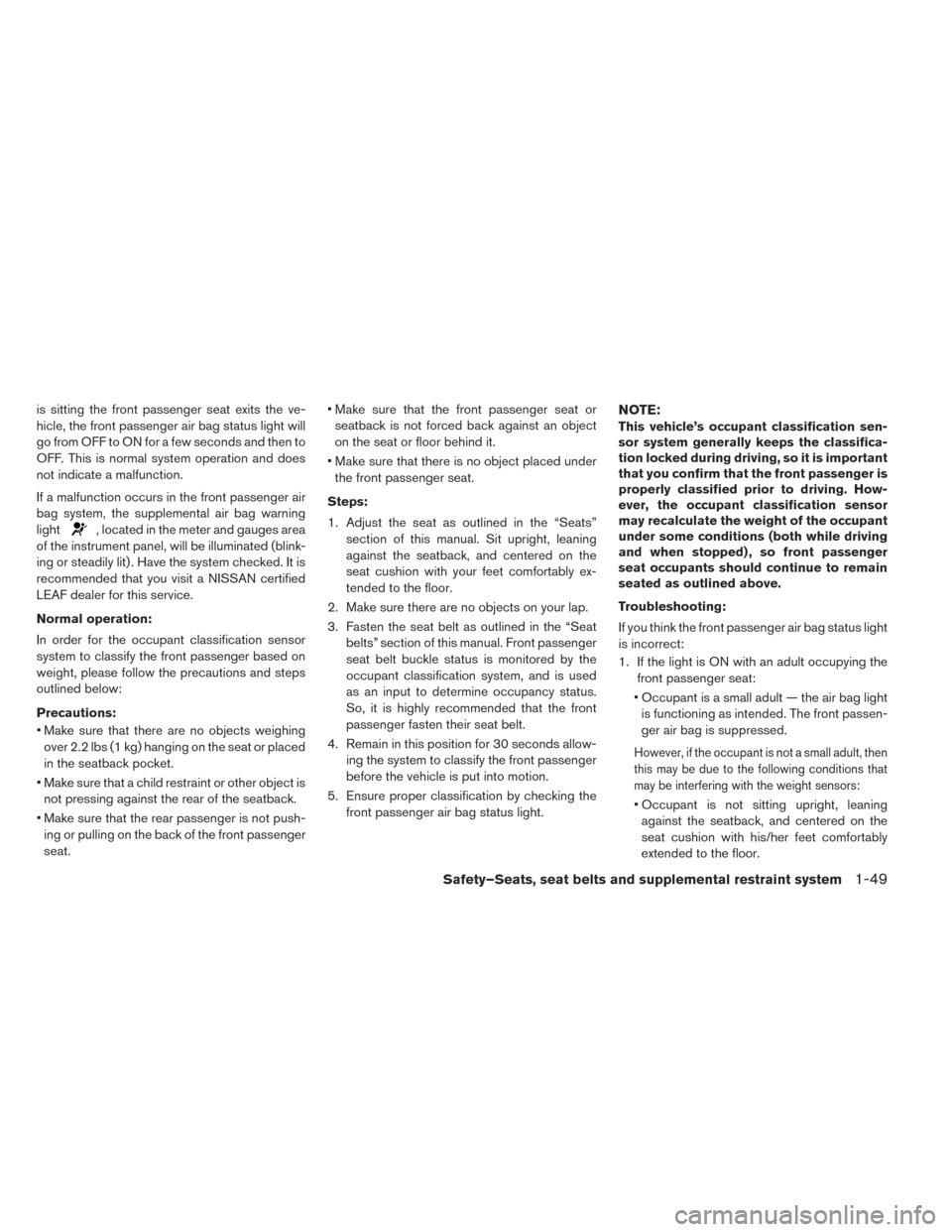
is sitting the front passenger seat exits the ve-
hicle, the front passenger air bag status light will
go from OFF to ON for a few seconds and then to
OFF. This is normal system operation and does
not indicate a malfunction.
If a malfunction occurs in the front passenger air
bag system, the supplemental air bag warning
light
, located in the meter and gauges area
of the instrument panel, will be illuminated (blink-
ing or steadily lit) . Have the system checked. It is
recommended that you visit a NISSAN certified
LEAF dealer for this service.
Normal operation:
In order for the occupant classification sensor
system to classify the front passenger based on
weight, please follow the precautions and steps
outlined below:
Precautions:
• Make sure that there are no objects weighing over 2.2 lbs (1 kg) hanging on the seat or placed
in the seatback pocket.
• Make sure that a child restraint or other object is not pressing against the rear of the seatback.
• Make sure that the rear passenger is not push- ing or pulling on the back of the front passenger
seat. • Make sure that the front passenger seat or
seatback is not forced back against an object
on the seat or floor behind it.
• Make sure that there is no object placed under the front passenger seat.
Steps:
1. Adjust the seat as outlined in the “Seats” section of this manual. Sit upright, leaning
against the seatback, and centered on the
seat cushion with your feet comfortably ex-
tended to the floor.
2. Make sure there are no objects on your lap.
3. Fasten the seat belt as outlined in the “Seat belts” section of this manual. Front passenger
seat belt buckle status is monitored by the
occupant classification system, and is used
as an input to determine occupancy status.
So, it is highly recommended that the front
passenger fasten their seat belt.
4. Remain in this position for 30 seconds allow- ing the system to classify the front passenger
before the vehicle is put into motion.
5. Ensure proper classification by checking the front passenger air bag status light.
NOTE:
This vehicle’s occupant classification sen-
sor system generally keeps the classifica-
tion locked during driving, so it is important
that you confirm that the front passenger is
properly classified prior to driving. How-
ever, the occupant classification sensor
may recalculate the weight of the occupant
under some conditions (both while driving
and when stopped) , so front passenger
seat occupants should continue to remain
seated as outlined above.
Troubleshooting:
If you think the front passenger air bag status light
is incorrect:
1. If the light is ON with an adult occupying thefront passenger seat:
• Occupant is a small adult — the air bag light is functioning as intended. The front passen-
ger air bag is suppressed.
However, if the occupant is not a small adult, then
this may be due to the following conditions that
may be interfering with the weight sensors:
• Occupant is not sitting upright, leaningagainst the seatback, and centered on the
seat cushion with his/her feet comfortably
extended to the floor.
Safety–Seats, seat belts and supplemental restraint system1-49
Page 136 of 424
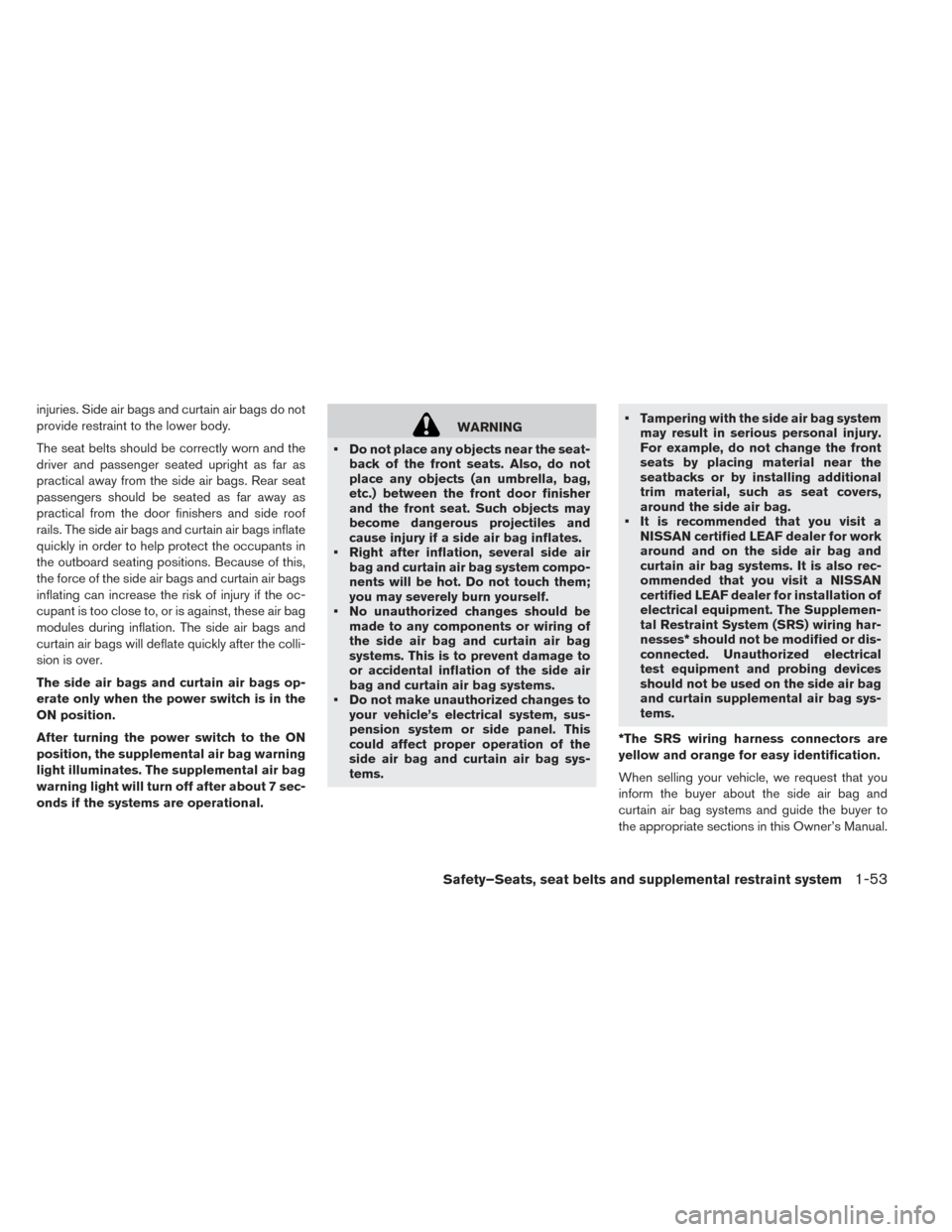
injuries. Side air bags and curtain air bags do not
provide restraint to the lower body.
The seat belts should be correctly worn and the
driver and passenger seated upright as far as
practical away from the side air bags. Rear seat
passengers should be seated as far away as
practical from the door finishers and side roof
rails. The side air bags and curtain air bags inflate
quickly in order to help protect the occupants in
the outboard seating positions. Because of this,
the force of the side air bags and curtain air bags
inflating can increase the risk of injury if the oc-
cupant is too close to, or is against, these air bag
modules during inflation. The side air bags and
curtain air bags will deflate quickly after the colli-
sion is over.
The side air bags and curtain air bags op-
erate only when the power switch is in the
ON position.
After turning the power switch to the ON
position, the supplemental air bag warning
light illuminates. The supplemental air bag
warning light will turn off after about 7 sec-
onds if the systems are operational.
WARNING
• Do not place any objects near the seat- back of the front seats. Also, do not
place any objects (an umbrella, bag,
etc.) between the front door finisher
and the front seat. Such objects may
become dangerous projectiles and
cause injury if a side air bag inflates.
• Right after inflation, several side air bag and curtain air bag system compo-
nents will be hot. Do not touch them;
you may severely burn yourself.
• No unauthorized changes should be made to any components or wiring of
the side air bag and curtain air bag
systems. This is to prevent damage to
or accidental inflation of the side air
bag and curtain air bag systems.
• Do not make unauthorized changes to your vehicle’s electrical system, sus-
pension system or side panel. This
could affect proper operation of the
side air bag and curtain air bag sys-
tems. • Tampering with the side air bag system
may result in serious personal injury.
For example, do not change the front
seats by placing material near the
seatbacks or by installing additional
trim material, such as seat covers,
around the side air bag.
• It is recommended that you visit a NISSAN certified LEAF dealer for work
around and on the side air bag and
curtain air bag systems. It is also rec-
ommended that you visit a NISSAN
certified LEAF dealer for installation of
electrical equipment. The Supplemen-
tal Restraint System (SRS) wiring har-
nesses* should not be modified or dis-
connected. Unauthorized electrical
test equipment and probing devices
should not be used on the side air bag
and curtain supplemental air bag sys-
tems.
*The SRS wiring harness connectors are
yellow and orange for easy identification.
When selling your vehicle, we request that you
inform the buyer about the side air bag and
curtain air bag systems and guide the buyer to
the appropriate sections in this Owner’s Manual.
Safety–Seats, seat belts and supplemental restraint system1-53
Page 137 of 424
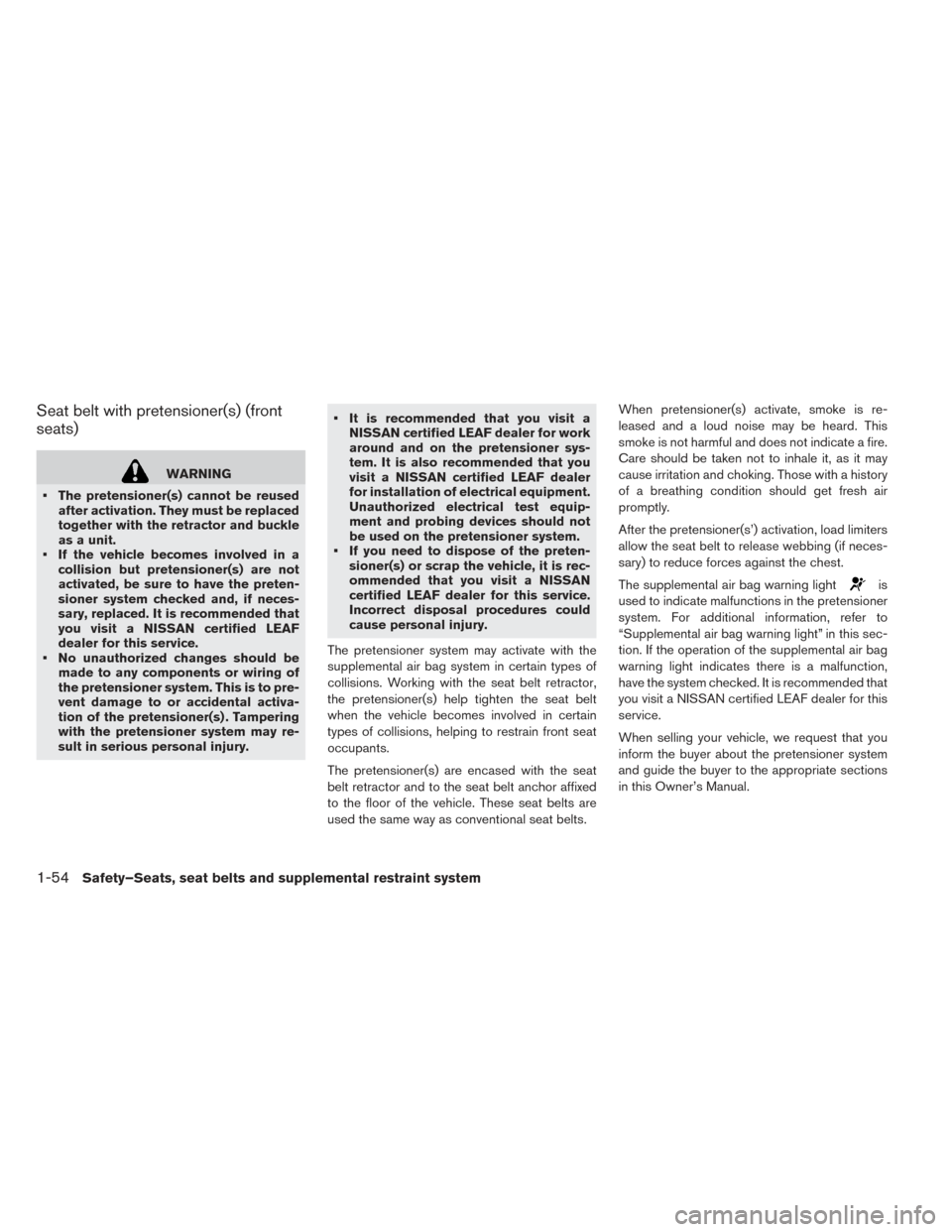
Seat belt with pretensioner(s) (front
seats)
WARNING
• The pretensioner(s) cannot be reused after activation. They must be replaced
together with the retractor and buckle
as a unit.
• If the vehicle becomes involved in a collision but pretensioner(s) are not
activated, be sure to have the preten-
sioner system checked and, if neces-
sary, replaced. It is recommended that
you visit a NISSAN certified LEAF
dealer for this service.
• No unauthorized changes should be made to any components or wiring of
the pretensioner system. This is to pre-
vent damage to or accidental activa-
tion of the pretensioner(s) . Tampering
with the pretensioner system may re-
sult in serious personal injury. • It is recommended that you visit a
NISSAN certified LEAF dealer for work
around and on the pretensioner sys-
tem. It is also recommended that you
visit a NISSAN certified LEAF dealer
for installation of electrical equipment.
Unauthorized electrical test equip-
ment and probing devices should not
be used on the pretensioner system.
• If you need to dispose of the preten- sioner(s) or scrap the vehicle, it is rec-
ommended that you visit a NISSAN
certified LEAF dealer for this service.
Incorrect disposal procedures could
cause personal injury.
The pretensioner system may activate with the
supplemental air bag system in certain types of
collisions. Working with the seat belt retractor,
the pretensioner(s) help tighten the seat belt
when the vehicle becomes involved in certain
types of collisions, helping to restrain front seat
occupants.
The pretensioner(s) are encased with the seat
belt retractor and to the seat belt anchor affixed
to the floor of the vehicle. These seat belts are
used the same way as conventional seat belts. When pretensioner(s) activate, smoke is re-
leased and a loud noise may be heard. This
smoke is not harmful and does not indicate a fire.
Care should be taken not to inhale it, as it may
cause irritation and choking. Those with a history
of a breathing condition should get fresh air
promptly.
After the pretensioner(s’) activation, load limiters
allow the seat belt to release webbing (if neces-
sary) to reduce forces against the chest.
The supplemental air bag warning light
is
used to indicate malfunctions in the pretensioner
system. For additional information, refer to
“Supplemental air bag warning light” in this sec-
tion. If the operation of the supplemental air bag
warning light indicates there is a malfunction,
have the system checked. It is recommended that
you visit a NISSAN certified LEAF dealer for this
service.
When selling your vehicle, we request that you
inform the buyer about the pretensioner system
and guide the buyer to the appropriate sections
in this Owner’s Manual.
1-54Safety–Seats, seat belts and supplemental restraint system